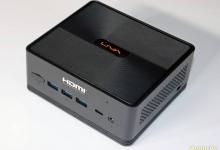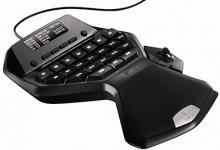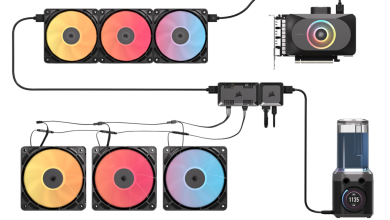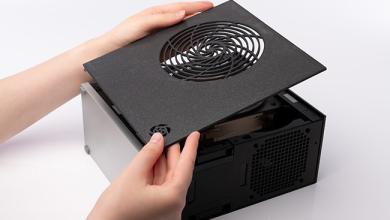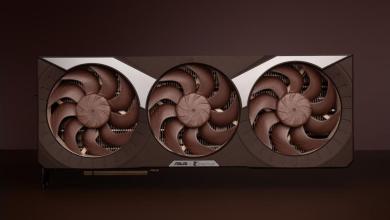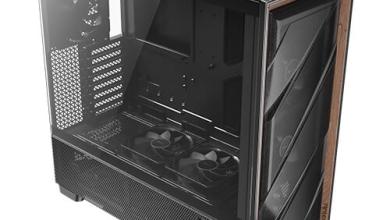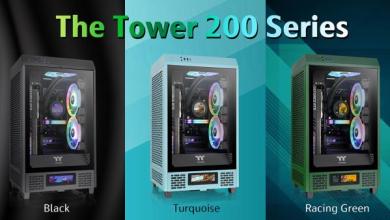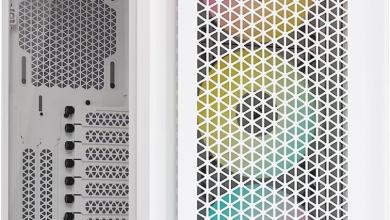Noctua Case Fans
A Closer Look |
|
NF-R8-1800
The NF-R8 offers up to 10% less noise than the current high-end fans rated at the same flow rate. The NF-R8 utilizes Noctua’s Raised-Blade-Design, which was developed by the Austrian Institute for Heat-Transmissions and Fan Technology. The Noctua NF-R8 has an optimized blade angle and surface to maximize the airflow and minimize the noise levels at below 1800 RPM.
Quote From Noctua: Raising the leading edge above the rotor hub and lowering the trailing edge below the bottom of the rotor hub results in an extended profile chord length, which compensates for the reduction in blade surface caused by the steeper angle of attack and hence increases the overall blade force. The continuous radial increase of the blade curvature towards the blade tips ensures sufficient static pressure despite of the slow rotation speeds. A significant reduction in noise emission is achieved through the rounding of the fan blades towards the rotor hub as well as the rounding of the rotor hub itself. 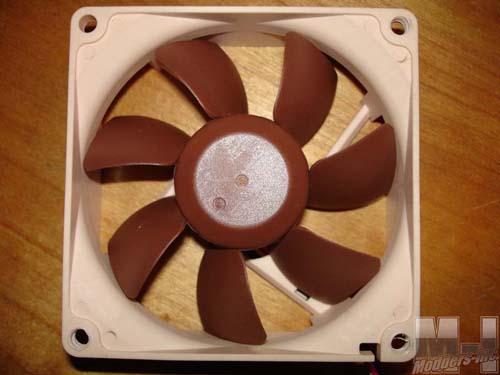 Looking at the straight on shot of the NF-R8 it resembles a standard fan for the most part. One of the first things you will notice besides the color is the rounded rotor hub on the fan. The NF-R8 offers a slightly steeper blade pitch, rounded rotor hub, and uses the SSO(Self Stabilizing Oil-Pressure) bearings which will give you a longer life span.
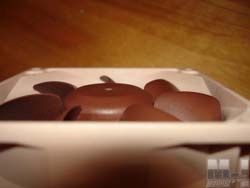 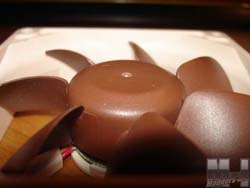 Here we have another view of the front of the fan. You can see the raised leading edges of the blades and the rounded rotor hub a little better. Noctua raised the leading edge and lowered the tailing edge of the blade to compensate for the reduction of the blade surface caused by the steeper angle of the blade.
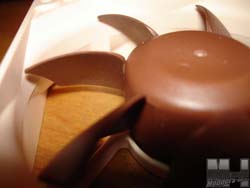 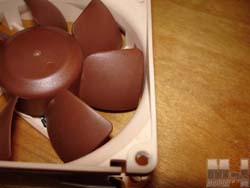 The curvature of the fan blades was optimized to ensure sufficient static pressure is present despite of the slow rotation speeds.. The two pictures above show the steeper pitch of the blade.
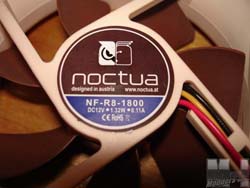 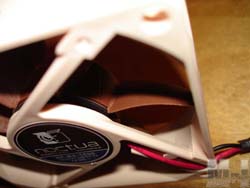 Looking at the rear of the Noctua NF-R8 we can see that it is rated at 12 Volts – 1.32 Watts – 0.11 Amps. The last picture shows the trailing edge of the fan blade extended past the rotor hub that we mentioned.
Specifications for the NF-R8-800:
NF-S12-800 / NF-S12-1200
The NF-S12 also offers up to 10% less noise than the current high-end fans rated at the same flow rate. The NF-S12 utilizes Noctua’s Straight-Blade-Design, which was developed by the Austrian Institute for Heat-Transmissions and Fan Technology. The Noctua NF-S12 has an optimized blade angle and is specifically tailored to 120mm fans with extremely low rotation speeds.
Quote From Noctua: The Straight-Blade-Design of the NF-S12 series provides the maximum efficiency of a straight fan blade without the drawback of higher noise emission, which arises when straight blades are used at higher rotation speeds. At the low rotation speeds of the NF-S series, the Noctua Straight-Blade-Design achieves a significantly higher flow rate than forward or backward swept blade designs. Furthermore, among other measures to prevent vortices like the rounded rotor hub, the distance between rotor and stator (tip clearance) was increased in order to reduce the problem of tip vortices which plays an important part in the noise emission of axial fans. With its fan blade exactly tailored to ultra low noise application, the NF-S12 series is significantly more quiet than other high end silent fans. 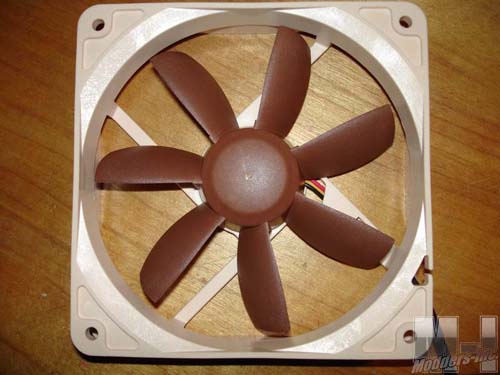 This shot will stand out to most people simply because of the major differences in the blade design. After seeing a picture of the NF-S12 I was glad to see that someone actually took the time to try something new. The NF-S12 utilizes the same round style rotor hub but has a slightly different approach on the blade design. These appear to be a little straighter from hub to tip and the tips are not quite as wide as a standard fan.
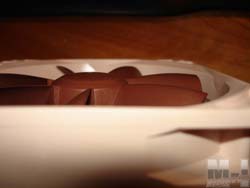 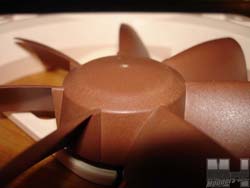 As you can see in these pictures. The blades are not protruding out quite as much and have a slightly flatter leading edge. These look to be an even steeper pitch on the blade when compared to the NF-R8 fans.
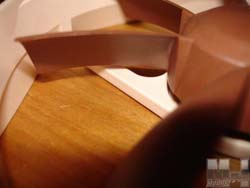 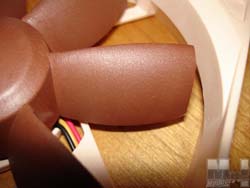 The blades still have a similar rake to them, its just on a smaller scale. Another thing that will probably catch your eye is the distance from the end of the blade to the outer housing. Noctua has increased this distance to reduce the noise levels produced by the fan.
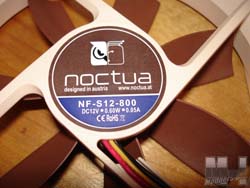 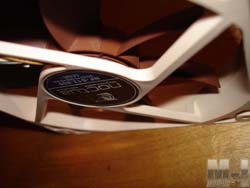
The NF-S12-800 is rated at 12 Volts – 0.60 Watts – 0.05 Amps, while the NF-S12-1200 is rated at 12 Volts – 1.44 Watts – 0.12 Amps. You can see in the next picture that the NF-S12’s blade is flush with the rear of the rotor hub.
SSO (Self-Stabilizing Oil-Pressure) Bearings: The rotating motion of the axis generates pressure upon the oil enclosed within the bearing. This creates the build-up of a dynamic pressure field that centers and stabilizes the axis within the bearing shell. Convention liquid bearings employ the principle of hydrodynamic pressure as well, the SSO bearing is equipped with an addition magnet that supports the self-stabilizations of the axis. This design allows for a faster, more precise, and more reliable centering of the rotor axis. This increases the long-term stability and quietness of the bearing itself. One problem that arises is the gyro effect. This is the initial precession of the axis under starting conditions, while the fan is building up the dynamic pressure field. Noctua addresses this with the built in magnet. The field of the magnet ensures the immediate self-stabilization of the rotor reducing the gyro effect. In addition to the stabilization during start up, the supporting magnet also allows for a more exact centering of the axis within the bear shell, which reduces bearing resistance, abrasion, and noise emissions. 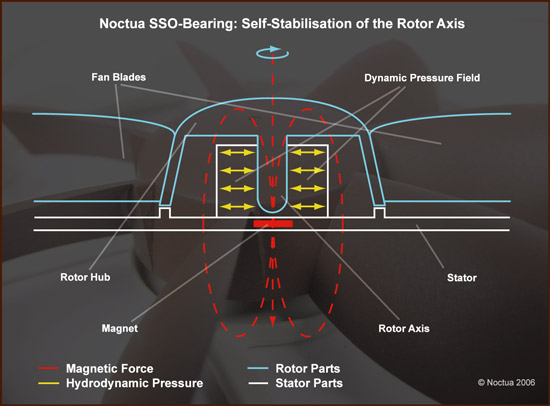 Image supplied by Noctua. SSO bearings compared to Sleeve and Ball bearings:
Most of us know that the standard sleeve and ball bearing designs have their drawbacks. The conventional sleeve bearings initially have a low noise level, and they have a shorter lifespan due to their design. The sleeved bearing fans I have here are rated at 30,000 hours and a noise level of 27.5dB(a). High grade ball bears will provide a more satisfying long-term solution. They also have a higher noise level when compared to the sleeved bearing. The ball bearing fans I have here are rated at 55,000 hours and a noise level of 34.25dB(a). The SSO bearing not only surpasses the quietness of conventional sleeve bearings but also the long-term stability of current top-of-the-line ball bearings. 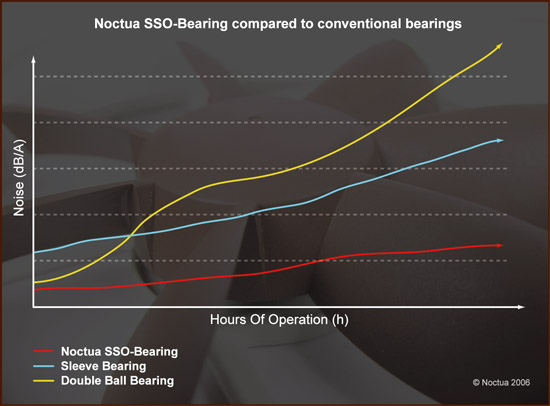 Image supplied by Noctua. |
